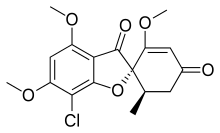 | |
 | |
| Clinical data | |
|---|---|
| Trade names | Gris-peg, Grifulvin V, others |
| AHFS/Drugs.com | Monograph |
| MedlinePlus | a682295 |
| Pregnancy category |
|
| Routes of administration | By mouth |
| ATC code | |
| Legal status | |
| Legal status | |
| Pharmacokinetic data | |
| Bioavailability | Highly variable (25 to 70%) |
| Metabolism | Liver (demethylation and glucuronidation) |
| Elimination half-life | 9–21 hours |
| Identifiers | |
| |
| CAS Number | |
| PubChem CID | |
| DrugBank | |
| ChemSpider | |
| UNII | |
| KEGG | |
| ChEBI | |
| ChEMBL | |
| CompTox Dashboard (EPA) | |
| ECHA InfoCard | 100.004.335 |
| Chemical and physical data | |
| Formula | C17H17ClO6 |
| Molar mass | 352.77 g·mol−1 |
| 3D model (JSmol) | |
| |
| |
| (verify) | |
Griseofulvin is an antifungal medication used to treat a number of types of dermatophytoses (ringworm).[1] This includes fungal infections of the nails and scalp, as well as the skin when antifungal creams have not worked.[2] It is taken by mouth.[1]
Common side effects include allergic reactions, nausea, diarrhea, headache, trouble sleeping, and feeling tired.[1] It is not recommended in people with liver failure or porphyria.[1] Use during or in the months before pregnancy may result in harm to the baby.[1][2] Griseofulvin works by interfering with fungal mitosis.[1]
Griseofulvin was discovered in 1939 from the soil fungus Penicillium griseofulvum.[3][4][5] It is on the World Health Organization's List of Essential Medicines.[6]
- ^ a b c d e f "Griseofulvin". The American Society of Health-System Pharmacists. Archived from the original on 20 December 2016. Retrieved 8 December 2016.
- ^ a b World Health Organization (2009). Stuart MC, Kouimtzi M, Hill SR (eds.). WHO Model Formulary 2008. World Health Organization. p. 149. hdl:10665/44053. ISBN 9789241547659.
- ^ Block SS (2001). Disinfection, Sterilization, and Preservation. Lippincott Williams & Wilkins. p. 631. ISBN 9780683307405. Archived from the original on 20 December 2016.
- ^ Ash M, Ash I (2004). Handbook of Preservatives. Synapse Info Resources. p. 406. ISBN 978-1-890595-66-1. Archived from the original on 31 December 2013.
- ^ Beekman AM, Barrow RA (2014). "Fungal metabolites as pharmaceuticals". Australian Journal of Chemistry. 67 (6): 827–843. doi:10.1071/ch13639.
- ^ World Health Organization (2019). World Health Organization model list of essential medicines: 21st list 2019. Geneva: World Health Organization. hdl:10665/325771. WHO/MVP/EMP/IAU/2019.06. License: CC BY-NC-SA 3.0 IGO.